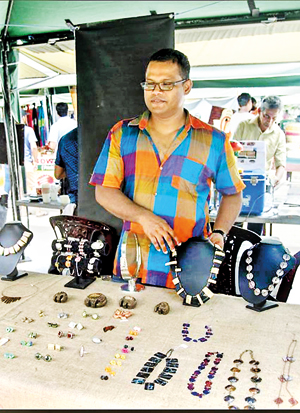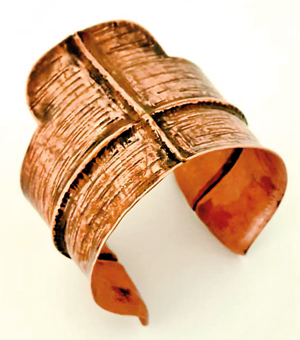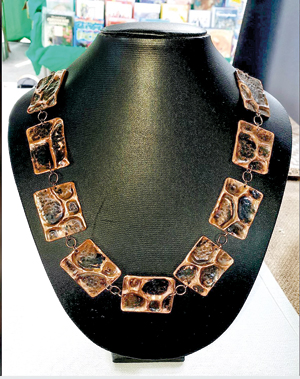One person’s trash another’s treasure

Chaminda lays out his works at a Sunday fair in Colombo
Where most people see trash, Chaminda Lorence sees trinkets – elegant rings, bracelets and necklaces, and decorative utility items for the coffee table, and perhaps even a coffee table itself. In old magazines, he sees delicate dangling elephant earrings and striking table-top clocks; in rusting copper wire, exquisite bracelets, arm bands and pendants.
Chaminda has mastered the alchemy of trash-to-treasure so well, few would know that the objects of adornment he creates started out their second life as discards. His company, C-Shapes, gathers old newspapers and magazines, and scrap metal and works with them until they become objects of great beauty.
C-Shapes was born of two deep passions: the desire to create, and love for the environment. Chaminda completed a diploma in jewellery and object design at the Jewellery School of Colombo Technical College, before moving on to PXL Hasselt in Belgium for higher training. It was at PXL that he decided to work with waste. The indiscriminate dumping of trash into landfills without any thought of what could be done with it had always bothered him, and so when time came to choose a material to work with, he ditched traditional precious metals such as gold, silver and platinum and opted for something even more precious, a ‘zero waste’ philosophy that allowed him to work with waste.
‘Zero waste’, a sustainability practice advocated at PXL, that encourages design in a manner that does not leave any residual waste, along with ‘urban mining’,the appropriation and reuse of waste from urban sites, inspired him. “We don’t let anything go to waste and try to make the maximum use of discarded items,” he says.

Scrap copper bracelet
His wife, Dr. Maheshi Dantherabandara, a senior lecturer in the Department of Chemical & Process Engineering of the University of Peradeniya, was an influencer and an invaluable asset, advising him on the choice of materials and warning against hazardous materials for personal health and safety. She is an expert in urban mining and knows a lot about reusable waste, he says.
Chaminda sees the pursuit of recycling trash as both a solution for waste management and a creative design challenge. He gathers his materials from friends, family, and local scrap metal collectors and uses both traditional and contemporary processes to create his works. For example, he processes the paper, applies glue and weighs down the pulp for a period of time until it dries, in the traditional way, before cutting it into shapes.

Scrap copper necklace
He works spontaneously. “When I see the material, I know what to do with it, and how to work with it,” he says. Because he approaches each work individually, it is unique: a one-of-a-kind work of art that even he cannot reproduce. “It’s unique because even if I can get the shape again, I cannot recapture the patterns and texture,” he says.
Chaminda and Maheshi also incorporate their philosophy of sustainability into their day-to-day life in their home in Kandy. “We compost our waste and get most of our vegetables from our rooftop garden,” he says. “I try to make the maximum use of most of my things.”
| C Shapes at CCC | |
| While the COVID-19 pandemic has affected sales, Chaminda is looking ahead on a positive note, with the hope of taking his works to both local and overseas markets. C-Shapes products will be available at Colombo City Centre from August 28-30. For more information, visit him on Facebook: @CShapes |


